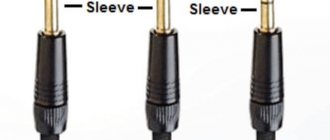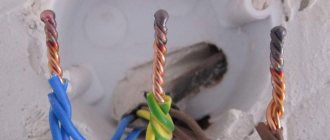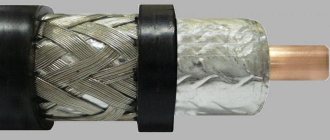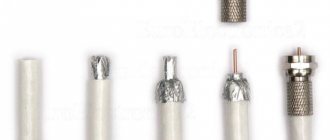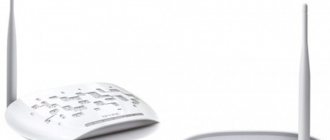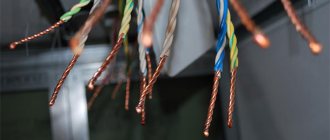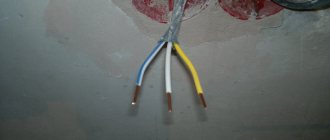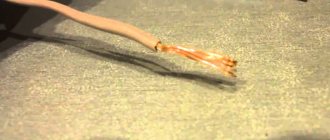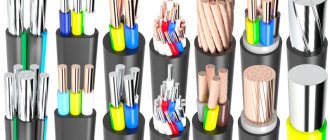In this article we will look at several ways in which you can extend your Internet cable. Do it yourself (using twisting) and without additional devices, or at minimal cost (using an adapter). Using the instructions in this article, you can also extend the network cable that you use to connect your computer to the router, or for other tasks. Not just the cable that your Internet provider installed into your home.
Most often, there is a need to extend the Internet cable that comes into our house or apartment from the provider’s equipment. Please note that we are talking about twisted pair cable. If you have, for example, fiber optics, then the solutions in this article will not work. During the repair process, when rearranging furniture, or moving devices, it turns out that the Internet cable is short and does not reach our computer or router. In this case, there are not many options: adjust to the length of the cable, ask the provider to lay a new cable of the length you need (which they are unlikely to do), or simply sharpen the Internet cable. What are we going to do now? But first, some tips:
- If you want to connect a regular network cable that you use to connect two devices (for example, a PC to a router), then this may not make any sense. It is easier to make a new cable of the required length. This will make it easier and the cable will be more reliable. Since any connection and especially twisting is not very good. You can make such a cable yourself, or ask to crimp the cable to the required length at some digital equipment store.
- Perhaps in your case it makes sense to install a Wi-Fi router (if you don’t already have one), rather than extend the cable and lay it through the entire apartment. And if there are desktop computers, to which a network cable is most often laid, then they can also be connected via Wi-Fi. You only need a Wi-Fi adapter, which I wrote about here.
- If we are talking specifically about connecting an Internet cable, then you can call your Internet provider and explain the situation. That you do not have enough length of the network cable laid into your house. Perhaps the provider will offer you some reasonable solution. For example, they will send specialists who will replace the cable free of charge.
- Internet sockets. If they are installed in your house/apartment, then consider possible connection options using these outlets.
If you cannot do without connecting a network cable, then it is best to use special connectors (coupler, joyner). If everything is done correctly, the quality of the connection will not suffer. I do not recommend using twists. They create additional resistance and this can greatly affect the stability of the connection. And ultimately on speed and ping. A computer or router may simply not see such a cable.
How to connect a telephone cable?
The need to splice a telephone cable arises when it breaks (for example, during an apartment renovation), as well as if the telephone socket is moved to another location and the cable needs to be extended. Every home master should be able to perform this operation.
You will need
- - wire cutters;
- - latex gloves;
- - electrical tape.
Instructions
- Pick up the handset on the parallel telephone that, despite the cable break, remained connected to the network. This will prevent ringing voltage from shocking the line if there is an incoming call. If you have only one device, or the break happened in such a place that all the phones in the apartment turned off, you will have to work with rubber gloves.
- Locate the cable damage. If it is impossible to find it visually, use a non-contact inductive fault finder. This device can be borrowed from the telephone operator for a while. In the absence of such a possibility, it is easier and faster to replace the entire cable section, the location of which is unknown.
- To splice an old-style two-wire flat cable on each side, bifurcate the “noodles” lengthwise with wire cutters so that the cut line runs exactly in the middle. Carefully clean the ends. Remember that the insulation of the “noodles” is not made of PVC, but of polyethylene, so when stripping, carefully calculate the force to remove only the insulation without damaging the core.
- Connect one of the wires at one end of the cable to any of the wires at the other end. Compliance with polarity is not necessary. Do the same with the remaining combination of wires. Carefully isolate the connections from each other. Then make sure that those telephones that stopped working after the break are working again.
- Telephone cables of the new design have an outer sheath, inside which two or four stranded conductors are laid in one row, each of which has its own colored insulation. The outer sheath can be easily removed with almost no risk of damaging the conductor insulation.
- If the cable is two-wire, the procedure for splicing it is the same as for the “noodles”. Repair a four-wire cable, which is much more common, as follows: do not connect the outer wires in the row anywhere or even strip them, since they are not used, and splice the wires in the middle in the manner described above.
- If a special telephone set is connected to the line, designed to operate simultaneously with two lines (they are found, although rarely, in offices), the outer wires may also be involved. Splice such a line by simply connecting conductors of the same color.
- After finishing your work and making sure that all telephones are connected to the line again, hang up the handset on the device from which you picked it up before starting work.
Rate the article!
imguru.ru
Features and connection diagram
Telephone sockets have their own individual connection features; if we talk about the modern and most common standards RJ-11 and RJ-12, they have the following connection nuances:
- The design of the device may include 2-4 contacts, which are small metal plugs. Between these elements, the cores of the supply wire must be buried.
- The telephones themselves are connected exclusively through 2 central contacts.
- To install devices with the specified standard, professional craftsmen use a special type of working tool called a cross-cutting knife. However, if you do not plan to use it frequently in the future, then you can limit yourself to a very ordinary knife with a sharpened blade. Such a tool is used to deepen the cores; when cutting through the insulating layer, contact will be ensured.
- Before straightening the cores, it is necessary to remove the outer layers from the wire; 4 cm is enough to carry out such stripping.
- For internal installation, it is recommended to use a KSPV cable, which has a single wire core in its design, which is most often made of copper. The outer shell is usually made of white colored plastic. TRP cable is most often used as a distributor.
connection diagram
How to connect a telephone cable | Do it yourself.
The need to splice a telephone cable appears when it breaks (say, during an apartment renovation), or also if the telephone socket is moved to another location and the cable needs to be extended. Every home craftsman should be able to perform this operation.
You will need
Instructions
1. Pick up the handset on that parallel telephone, the one that, despite the cable break, remained connected to the network. This will prevent the shock of the ringing signal voltage that may occur on the line in the event of an incoming loudspeaker. If you each have one unit, or a break occurred in such a place that all the telephones in the apartment turned off, you will have to work in rubber gloves.
2. Locate the cable damage. If it is impossible to detect it visually, use a non-contact inductive fault finder. You can temporarily borrow this device from the telephone operator. In the absence of such a probability, a section of cable whose break location is unknown is easier and faster to replace entirely.
3. To splice a two-wire flat cable of a dilapidated design on all sides, bifurcate the “noodles” with wire cutters so that the cut line runs correctly in the middle. Carefully clean the ends. Remember that the insulation of the “noodles” is made not of PVC, but of polyethylene, therefore, when stripping, correctly calculate the force in order to remove only the insulation without damaging the core.
4. Connect one of the wires of one end of the cable with any of the wires of the other end. Compliance with polarity is not necessary. Do the same with the remaining combination of wires. Carefully isolate connections from each other. After this, make sure that those telephone units that stopped working after a break are working again.
5. Telephone cables of the new design have an outer sheath, inside of which two or four multi-core conductors are laid in one row, each of which has its own colored insulation. The outer sheath can be easily removed with approximately no risk of damaging the conductor insulation.
6. If the cable is two-wire, the procedure for splicing it is the same as for the “noodles”. Repair the four-wire cable, the one that is much more common, in the following way: do not connect the outer wires in the row anywhere or even strip them, since they are not used, and splice the wires located in the middle using the method described above.
7. If a special telephone unit is connected to the line, designed to work with two lines at a time (they are found, although rarely, in offices), the outer wires may also be involved. Splice such a line by primitively connecting conductors of the same color.
8. Having completed the work and making sure that all telephones are again connected to the line, hang up the handset on the unit from which you removed it before starting work.
Tip 2: How to connect a telephone cable to a telephone jack
Do you want to install a wired telephone in a comfortable place, but there is no socket to connect it? Installing it is not difficult at all. Performing this operation independently will take much less time than waiting gruelingly for a telephone operator.
You will need
- — telephone socket;
- - screwdriver;
- - wire cutters;
- - telephone cable;
- — cable box;
- - self-tapping screws;
- - screwdriver.
Instructions
1. Installation of an additional telephone socket in some cases can be avoided. To do this, you will need to buy a cord for your phone of such a length that it is enough to connect it to an existing outlet. To connect units that have a permanent cord, you can use a telephone extension cord.
2. If you decide to install an additional outlet, you need to buy it first. They come in 2 types: tiny RJ-11 and large RTShK-4. Look at what kind of plug your telephone unit has and choose the appropriate socket for it. At the same time, purchase a telephone cable and a cable box of the required length, as well as self-tapping screws.
3. Take the cable box and secure it with self-tapping screws along the path from the existing telephone socket to the installation site of the new one. Route the cable inside the box and then close it.
4. Screw the new outlet to the wall. Connect the cable to it as follows. If this is an RJ-11 socket, connect the cable conductors to the two middle contacts, and leave the two outer ones free. If you are installing an RTShK-4 type socket, open the plug of your telephone unit and look at which contacts the wires are connected to. Connect the cable conductors in the socket to the same contacts. For reference: according to the standard, in the RTShK-4 socket it is customary to connect the wires to the two right contacts, but this requirement is not always observed. Cover the plug and socket.
5. Open up the old socket. Pick up the handset on any parallel telephone in the apartment so that the line cannot receive a call signal that could cause an electric shock. Connect the new cable in parallel with the old one. Close the socket and hang up on the parallel telephone.
6. Connect your phone to the old socket. Make sure it works. Also make sure that the remaining parallel units have not lost their functionality.
Tip 3: How to combine 2 sockets
Of all the electrical switching devices known to society, the most common are sockets, the main function of which is to create correct contact with the plug of the device connected to it. The number of electrical appliances used by a person is becoming larger and larger every day, while the number of sockets in the room remains unshakable. You can relieve the load on one of them by connecting a second socket to it, and in order not to drag extra wires from the electrical unit, they must be combined with each other. This can be made easier for everyone through a parallel connection.
You will need
- — multimeter or indicator;
- — soldering unit;
- — a set of screwdrivers.
Instructions
1. Parallel connection of sockets is the least dangerous, and therefore especially famous. In addition, it can be easily done with your own hands. But it must be remembered that it is only suitable for sockets belonging to the same group.
2. First, turn off the machine in order to remove the voltage from the plug-in socket. This can be done by unscrewing the plugs, if they are used, or by turning off the mechanical switches at the input.
3. Check for lack of voltage. To do this, you can use an ordinary voltage indicator, multimeter or indicator. Only after making sure that there is no voltage will you be allowed to remove the socket cover and touch the exposed wires and contacts with your hand.
4. It is possible to connect an electrical outlet with a parallel connection through a distribution box or with the help of terminals. The 2nd method is also called a daisy chain connection. When using a loop, the cable is connected to the first unit of the block, while the cable for the further block will be powered from the last one.
5. For a daisy chain connection, it is very important that the sockets are disconnected from each other. To do this, connect the conductors with neutral conductors using terminals or soldering. Connect the neutral and phase to the first electrical outlet. After this, apply a clamp to the ground wire. A grounding wire will be supplied from it to each of the electrical units.
6. To connect the second socket, connect the phase and working zero from the last unit of the first block, and connect the ground wire to the compressor.
7. After the work is completed and the working parts of the sockets are correctly installed in the socket boxes, you can screw on the covers and turn on the machine.
Note!
The materials of all wires used must be the same. For example, it is impossible to connect copper wires with those made of aluminum. If you cannot avoid connecting wires made of different materials, it is important to tin them before connecting.
Helpful advice
Carrying out a parallel connection requires the performer to comply with safety precautions, and therefore it is important not to lose sight of even minor nuances. When connecting wires to contacts, you need to curl the end of the wire in the shape of a ring. This is required to create a sufficient contact area.
jprosto.ru
Step-by-step instruction
Initially, we will consider a simple way to connect a universal telephone socket. Today, the most common devices are those that comply with European standards RJ-11 and RJ-12.
In order to connect them, you must adhere to the following algorithm of actions:
- Initially , you will need to turn off the power supply and put on protective gloves, since the voltage in the telephone network is 60V, and in working condition it can reach 110-120V.
- Using side cutters to remove the insulating layer from the conductors, it is important not to touch the conductors themselves. The length of the stripped cable should be about 4 cm.
- Using a tester, determine the polarity of the contacts.
- Connect the conductors to the contacts. In a telephone jack, the red wire has negative polarity, and the green wire has positive polarity. It is not necessary to follow the connection rules taking into account polarity, but there is a certain risk that in the future the telephone set will from time to time make its own during operation.
- Connect the cable cores , then tighten and ensure reliable fixation using special screws for clamping.
- Some models have 2-4 contacts in their design, which have a fork shape; these elements are made of steel. In such a situation, 2 central contacts are used.
- Fix and fasten the telephone socket on the wall surface. This can be done using double-sided tape, but the most effective way is to use self-tapping screws.
- Snap the cover of this device.
How to connect a telephone cable?
If a telephone cable breaks at home or in the office, or if it is severely damaged, it often becomes necessary to splice this cable. In addition, very often you need to connect the telephone cable when moving the socket to another location and for some other reasons.
1. To deal with this problem, you can call a telephone technician, or you can try to connect the telephone cable yourself.
2. To connect the telephonogram cable, it is necessary to take precautions, carry out all work with gloves and lift the handset on the telephone mechanism to avoid electric shock in case of a call.
3. Then you need to find the location of the damage to the cable itself. If you cannot find it yourself, then you should use a special damage finder. To merge a two-conductor cable, you must initially bifurcate the ends of the cable itself, so that the cut line runs exactly in the middle, and then carefully strip its ends so as not to damage the core itself.
4. After this, you need to merge the wires of one end of the cable with the cords of the other end of the cable and connect the telephone set to make sure that it works again.
1. If the telephone set is of a new design, then it has a casing, inside of which there are several rows of multi-core cables.
2. Such a sheath can be removed very easily and there is absolutely no risk of distortion of the conductor protection.
3. If the cable has four wires, then it is necessary to use only two wires that are located in the middle, and do not touch the outer ones at all and do not connect them anywhere.
4. The same wires that are located in the middle must be stripped of excess insulation and then connected to each other at the break point. After this, you need to check whether the phone is working and insulate the cable.
5. If a special device is connected to such a line, then it is necessary to splice all four wires together, because all of them can be involved in the work.
questione.ru
Required tools and materials
Depending on the type of telephone jack, as well as the standard used, different tools and materials may be required.
However, it is recommended to have all the necessary equipment available at once:
- Screwdriver , which in terms of the type of working surface and dimensions corresponds to the screws used to fasten the device. The screwdriver handle must be insulated to avoid electric shock.
- Socket box.
- Cable if the old device is not being replaced, but a completely new one is being installed.
- A hammer drill , as well as a cable, will be needed if a new outlet is being installed.
- The outlet itself.
- Knife with a sharp blade.
- Self-tapping screws.
- Wire cutters.
- Insulating tape.
- Universal multimeter or tester.
- Protective gloves.
- Single-sided and double-sided adhesive tape.
- Graphite pencil and marker with bright paint, which will be needed for marking.
Old and modern device standards
As equipment has improved, the way phones connect to the communications network has undergone a number of changes. In the first models of telephones, connection to the communication line was carried out without the use of sockets at all.
To create a closed current loop, the wires were simply twisted together or connected by any other available means.
In the 80s of the last century, connections between telephone exchange lines were made using two-core copper wires. And to ensure a quick-disconnect connection to the telephone, sockets and plugs of the RTShK-4 standard were used. This abbreviation stands for "four pin telephone socket."
The RTShK-4 design includes a key and two pairs of contacts. The first pair ensures the phone operates in normal mode, the second pair allows you to connect an additional line, provided that both devices are on the same phone number.
As a result of the widespread dissemination of microprocessor technologies, Registered Jack equipment marked “RJ” began to be actively used to replace obsolete models of the RTShK-4 standard. It complies with the international standard IEC 60884-1 and 60669-1.
Connection of modern landline telephone models for use at the household level is carried out through sockets equipped with one pair of contacts. The housings of such devices are mounted in the cavity of a plastic module and are marked with RJ-11 symbols.
Between the two contacts, which are compact metal plugs, the cores of the supply wire are buried. Models of the RJ-11 standard are recommended for connecting devices to linear telephone lines.
To connect two devices to separate lines and create office mini-PBXs, RJ-12 and RJ-14 standard devices are used. Universal four-wire connectors are suitable for most models of telephone equipment.
To connect several devices at once, you just need to assemble the sockets sequentially into blocks, while observing the diagram: the first line is connected to contacts No. 2 and No. 3, and the second - to No. 1 and No. 4. Devices of this series are mostly used to create mini-PBXs when arranging office premises.
Installing an adapter allows you to connect plugs of both old and new standards with lines equipped with modern technologies.
The main difference between RJ-25 standard devices is three pairs of working contacts. For this reason, the connection of such equipment can only be carried out by a qualified specialist who is well versed in telephony and electrical issues.
When connecting computer systems, faxes, modems and other complex communication devices, the RJ-45 standard is also used. When connecting RJ-45 devices, the main attention is paid to the matching of the plastic keys.
Despite the design differences between the old and new standards, the device plugs have similar connectors and dimensions. The device is connected to the network only through two contacts. Only modern models use only middle contacts.
For those wishing to familiarize themselves with the connection features, the photo gallery will help:
Bolted connection
A fairly common connection method is a bolted connection. For this type you need a bolt, at least two washers and a nut. The diameter of the bolt depends on the thickness of the wire. It should be such that a ring can be made from the wire. If wires of different sections are connected, then the bolt is selected according to the largest one.
To make a bolted connection, the end is cleared of insulation. The length of the stripped part should be such as to make a ring that fits onto the bolt using round pliers. If the wire is stranded (flexible), then the length should allow, after making the ring, to wrap the free end around the wire near the insulation.
In this way, you can connect only two identical wires. If there are more of them, or they are different in cross-section, rigidity and materials (copper and aluminum), then it is necessary to install conductive, usually steel washers. If you take a bolt of sufficient length, you can connect any number of wires.
Adviсe
All the main issues relating to the installation and connection of telephone sockets have been considered, summing up the following useful recommendations:
- The most popular today is the built-in type of device, since it fits harmoniously into any room and is an extremely inconspicuous element. However, it must be taken into account that its installation will take longer and the wall decoration will suffer.
- It is best to purchase devices that were produced by well-known and trusted manufacturers who have managed to positively establish themselves in this field. Today, such companies are Legrand and Vico.
- On some models, there may be no contact numbering, which is usually printed on the body of the device. In this case, knowing the rules of color marking can help: green, orange or blue in combination with white are used to indicate positive contacts; the same colors, only monotonous and without the addition of white, indicate negative contact.
- If you are installing an old-style , then it will not hurt to also know the color marking rules that were used before: orange, black or green conductor is positive; the red, yellow or blue conductor must be negative.
Despite the rapid decline in the popularity of landline telephones, there are not so many people who are ready to refuse them outright. Admit it, it happens that it is sometimes extremely difficult or even impossible to do without a traditional connection.
To connect the device to the switching network, you need a low-current node, the installation of which can be done by yourself. We will tell you in detail how to connect a telephone socket without calling a technician.
Installation diagrams and connection methods
Connecting a telephone socket is much simpler than its electrical counterpart. But a process that involves working with, albeit low, but still voltage, requires accuracy and caution.
When installing a telephone socket, you can use one of two installation methods:
- open - involves installation in an overhead manner;
- closed - in which the telephone line is hidden inside the wall.
When choosing a laying method, they are guided by the design of the walls, the service conditions of the communication line and the pretentiousness of the design of the room itself. Surface-mounted sockets do not look very aesthetically pleasing, but they are ideal for speed of maintenance: in a matter of minutes they can be removed from the support and the integrity of the contacts can be assessed.
To protect exposed wires from mechanical damage, decorative plastic cable channels are used. They are found on sale in the form of wall structures and floor skirting boards. It is convenient to monitor the condition of the wire in them through one- or two-sided snap panels.
For closed installation, KSPV cable is most often used. The single core of this cable is made of copper wire, and the outer sheath is made of polyethylene, painted white.
The telephone line is also laid using the TRP distribution cable. It has a dividing base. The core of this single-pair wire is also made of copper and insulated with polyethylene.
To decorate the connection points and make them less noticeable to prying eyes, the devices are placed behind TV screens and monitors, and are also built behind the façade of wall-mounted furniture.
A separate line should be highlighted for sockets built into the baseboard. The main thing is to choose models whose front panel fits tightly to the surface of the baseboard. Otherwise, over time, it will begin to move away from the base, exposing unsightly seams.
Connecting wires and cables using couplings
If the cable to be connected is in the ground, water or rain, then conventional methods of isolating the connection are not suitable. Even if you apply a layer of silicone sealant to the cable and compress it with heat-shrink tubing, this will not guarantee tightness. Therefore, it is necessary to use special couplings.
Couplings are available in plastic and metal casings, poured and heat-shrinkable, high-voltage and low-voltage, regular and small-sized. The choice of coupling depends on the specific operating conditions and the presence or absence of mechanical loads.
Connecting wires and cables is one of the most important points in electrical installation. Therefore, all methods of connecting electrical wires must ensure good contact. Poor contact or poor insulation may result in short circuit and fire.

